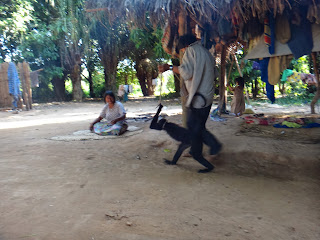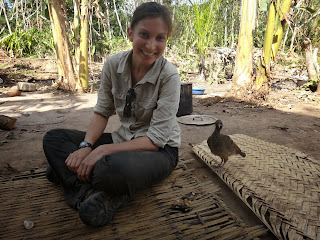When you're living in the Bolivian Amazon among a population that uses hunting as one of its primary modes of livelihood, you come upon some pretty awesome animals in your daily life. When Tsimane' go hunting, usually in the old-growth forest (which depending on the community and how far away it is from San Borja can be 1 hour or more than 5 hours away on foot), the main objective is to kill one of a variety of small animals for protein. However, many times, depending on the size of the animal and how much success they've had during the hunt, they will catch the animals and bring them back to the community. Many of the animals become somewhat domesticated with the Tsimane' feeding them and letting them grow before being eaten.
Here is a Wasu - or a forest deer. Vicente, one of the translators, picked up this deer and said "Bambi" while we were in one of the communities upriver.
Many Tsimane' come upon monkeys in the old-growth forest and will catch the babies and then raise them as pets for several years. Agustina in Campo Bello had caught this monkey.
Last summer when Asher was in Campo Bello, he was giving his introductory speech to the community, describing his study when one of the families had brought this monkey to the meeting. It caught him a little off guard as the monkey was playing the whole time with the girl's hair (pictured below) while he was giving his speech.
They've since adopted another small, brown monkey (6 months old) that was pictured in our last blog post with Kelly. This one also liked to bite, but we think he was just playing.
Here he is playing with our first guide. He was really curious.
At another one of the families' houses, we encountered what they called a "mono del noche" or a nocturnal monkey. He was Asher's favorite. As Asher moved around, the little guy kept running after him and would stop when Asher stopped. This went on for a good 10 minutes (about the length of Asher's attention span when playing with animals).
He was also very camera friendly.
A few of the families also had Capybaras, who they caught in the pampas. Capybaras - the world's largest rodent (ROUS's) live in the water, but once you bring them to your household, surprisingly, they will hang out with you and not run away.
The kids like to put them on leashes and take them for walks, which the capybaras seem to enjoy as much as cats like going on walks.
The community also had a fair amount of exotic birds. One of the guys in particular had a ton of animals, including a capybara, more chickens and dogs than you could count, cows, and then a few birds. He also had an ostrich-like bird. Asher asked Enrique where he got the ostrich. Enrique told us that his son found an egg, brought it to him, and now he has a giant bird that others in the community joke is his girlfriend. Apparently several of the taxi drivers that come through have offered to buy it from him.
Enrique had so many different animals at his household, including this incredibly ugly bird that we haven't been able to identify. Anyone know what this is?
Several of the families also had parrots that talk.
Finally, here is a wild bird that one of the families found in the old-growth forest (ave del monte) that really loved the camera and people. The bird took an immediate affinity to Kelly.
In our next post, we'll talk about a typical day in our lives in the field. Maybe we'll share some funny stories, including one about a very unfortunate mouse.














No comments:
Post a Comment